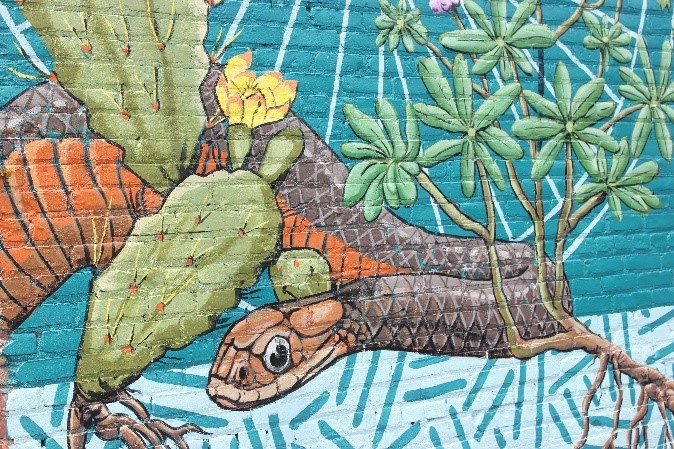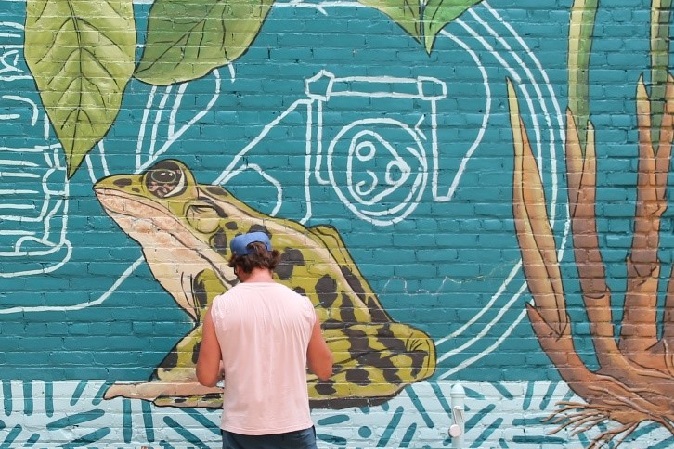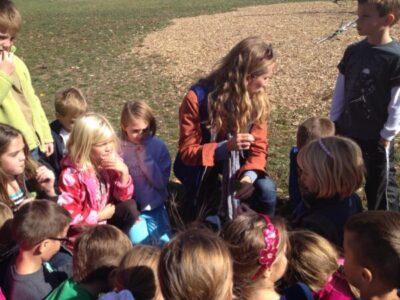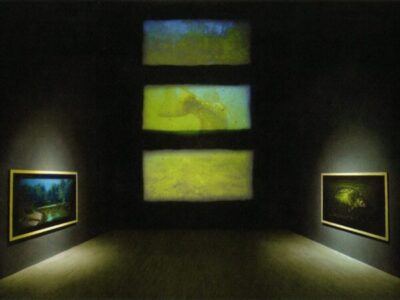
This article was republished here with permission from Great Lakes Echo.
By Clara Lincolnhol, Great Lakes Echo
Toledo, Ohio, has a rich Rust Belt history that influences its present-day culture. Local environmental groups and agencies are turning to public art to teach residents that the area’s natural history is just as important.
Toledo lies in what was once the Great Black Swamp. It was a massive system of wetlands that stretched from Lake Erie to current-day Fort Wayne, Ind., before most of it was drained and developed or converted to agricultural production. The remaining prairie and wetland ecosystems and the native plants they support are still essential to supporting clean water in northwest Ohio.
“Telling this story through something visual that beautifies a community is a great way to educate Toledo residents and reconnect them to nature in the place they call home,” said Rob Krain, executive director for the Black Swamp Conservancy.
“I believe the intersection of arts and nature is really important for connecting and inspiring people,” Krain said. “Bringing it into the urban community is particularly important, because there can be a disconnect between our urban and natural areas.”
The conservancy is a Toledo-based environmental organization that restores wetland and floodplains to support clean water. To tell a visual story of Toledo’s environmental history, they partnered with the Arts Commission of Toledo and creative firm Graphite Design + Build to paint three murals downtown, Krain said.

The Main Street mural depicts native wetland plants and animals like the leopard frog. (Image courtesy of Black Swamp Conservancy)
All three murals highlight the region’s native plants and the important role they play in the water cycle. They primarily show plants that live in the prairie and wetland ecosystems of northwest Ohio.
Deep-rooted native plants help retain water on land and prevent run-off, which would otherwise lead to harmful algae blooms in nearby Lake Erie and threaten safe drinking water, Krain said.
Toxic algae blooms caused the three-day long Toledo Water Crisis in 2014, when city officials sent out urgent warnings to residents not to drink or use their tap water due to elevated toxin levels.
Painting plants
One mural on East Main Street shows plant species including Jack-in-the-pulpit, trout lily and lady slipper, all found in wetland habitats. The mural is located in what was once a floodplain area before human development, Krain said.
Another mural on Adams Street depicts the prickly pear cactus, blue lupin, mayapple, common and swamp milkweed. They’re all found in the oak openings habitat, a rare ecosystem found in western Lucas County.
“It’s sand deposit from the last glacial age, and within that deposit exist very rare habitat types including oak savannas, wet prairies and sand barrens,” Krain said.
Ohio’s highest concentration of endangered plant and animal species live in those rare habitats, he said.
A third mural, completed in 2023 on Hamilton Street, depicts the lakeside daisy, a rare flower that lives only in limestone outcroppings found in small pockets of Ohio, Michigan, Illinois and Ontario.
“It’s kind of like a dinosaur in itself,” said Doug Kempher, owner and designer of Graphite Design + Build.
The flower is extremely uncommon because the habitat it needs to live is uncommon too, thanks to industrial development and fire suppression. It can’t compete with other prairie species or trees either, Kempher said.
Each mural has a criss-crossed zigzag pattern underneath the plants which represents their roots and water filtering ability, he said.
“These plants are literally holding the land together and filtering our water,” Kempher said.
Graphite Design + Build has created other murals in the Toledo area that focus on the importance of water-filtering plants, like the “cross section of a wetland” installation at the Magee Marsh Visitor Center.
“How little is left”
Educating the public about these issues is crucial, said Eric Saas, program manager H2Ohio, a state water quality initiative.
Through the work of the Ohio DNR and other agencies, H2Ohio aims to prevent pollution, fertilizer run-off and algae blooms by expanding and restoring wetland habitats.
“In large part that land has been converted for productive agriculture and other uses,” Saas said. “We’re missing those ecosystem services that all that acreage of swamp provided for us, and unfortunately we’re dealing with the consequences of that.”
To prevent run-off, H2Ohio speaks with farmers to develop and implement the best farming practices so excess nutrients do not make their way into the watershed and Lake Erie, Saas said.
“It’s hard to get people to care about something, or want to protect something they don’t know very much about,” he said. “Start with the basics of the importance of wetland ecosystems, the context of how much acreage we had and how little is left, and then the importance of putting that piece back on the landscape.”
Engaging with art
In addition to murals, Graphite Design + Build has made art installations in partnership with Metroparks Toledo. The pieces pay homage to both the natural world and Toledo’s industrial history. Their art can be found at multiple metroparks, said Scott Carpenter, director of public relations for Metroparks Toledo.
One art piece, called The Beacon, represents the smokestack that used to sit on the banks of the Maumee River before that land was turned into Glass City Park, Carpenter said.
“It sat there mothballed for decades, and on this former industrial riverfront that’s now a great welcoming green space for the public,” he said.
More than 10,000 trees have been planted along the Maumee River in Glass City Park, restoring wooded areas, preventing erosion and sediment from getting into the river and Lake Erie. Of the 13,000 acres of metroparks, 80% of the land is used for conservation, he said.
“We’re all about conserving natural resources and then engaging people with them. Art is so perfect for that,” Carpenter said.
Catch more news at Great Lakes Now:
Composting, water access and backyard chickens: Detroit’s urban farming evolution
Nibi Chronicles: A conversation about Ojibwe history in Fur Trade Nation
Featured image: The Adams Street mural depicts arid plants, like the prickly pear cactus and lupin with a northern ring-necked snake resting behind them. (Image courtesy of Black Swamp Conservancy)




